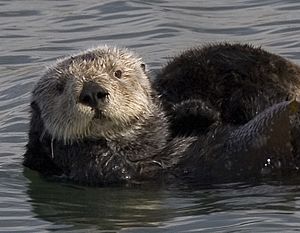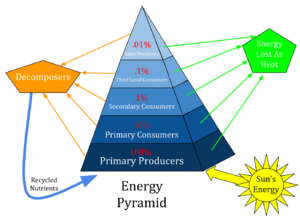Food chain facts for kids
A food chain shows how living things get their energy by eating other living things. It's like a path that energy takes from one creature to the next. This path usually starts with plants or tiny algae, which make their own food. These are called producers. Then, animals that eat plants are next in the chain. Finally, the chain often ends with a top predator, or with tiny organisms that break down dead matter.

A food chain is different from a food web. A food chain is a simple, straight line. A food web shows many food chains connected together, like a big network. Understanding food chains helps us see how important each living thing is in nature. If one part of the chain is missing, it can affect many other species.
Contents
What is a Food Chain?
A food chain is a way to understand how energy moves through an ecosystem. It shows who eats whom. This movement of energy is vital for all life on Earth. The stability of these chains is very important for many species to survive. If even one part of a food chain is removed, it can cause big problems. It might even lead to some species disappearing.
Food Chains vs. Food Webs
It's easy to confuse a food chain with a food web, but they are different.
- A food chain is a direct, single path of who eats whom. It shows a simple flow of energy. For example, grass is eaten by a rabbit, and the rabbit is eaten by a fox.
- A food web is much more complex. It shows all the different food chains in an ecosystem connected together. It's like a giant map of who eats what. Most animals eat more than one type of food. This makes food webs more realistic than simple food chains.
How Energy Moves in Nature
Energy moves through different levels in a food chain. These levels are called trophic levels. Each level depends on the one below it for energy.
Producers: The Energy Makers
At the very bottom of almost every food chain are the producers. These are living things that make their own food. Most producers, like plants and algae, use sunlight to make food through a process called photosynthesis. Without the sun, most life on Earth could not exist.
However, some amazing life forms, called chemotrophs, live in places without sunlight. They get energy from chemicals, often found near hydrothermal vents deep in the ocean. These special bacteria and archaea form the base of food chains in those dark environments. No matter how they get their energy, producers are the starting point for all food chains.
Consumers: The Eaters
Above the producers are the consumers. Consumers cannot make their own food. They must eat other organisms to get energy.
- Primary consumers are herbivores. They eat only producers (plants or algae). Think of a rabbit eating grass.
- Secondary consumers are carnivores or omnivores. They eat primary consumers. A fox eating a rabbit is a secondary consumer.
- Tertiary consumers eat secondary consumers. An eagle eating a snake, which ate a frog, which ate an insect, is an example.
At the very top of many food chains are apex predator]]s. These are consumers that have no natural predators themselves. They are at the top of their food chain.
Decomposers: Nature's Recyclers
When any living thing in a food chain dies, it doesn't just disappear. That's where detritivore]]s and decomposer]]s come in. These organisms, like earthworms, fungi, and bacteria, break down dead plants and animals. They turn the organic material back into simple nutrients. These nutrients then return to the soil or water. Plants use these nutrients to grow, starting the food chain all over again. Decomposers are super important for recycling nutrients in nature.
The Length of a Food Chain
The length of a food chain is simply the number of links or steps from the producer to the top consumer. For example, a short chain might be: grass → cow → human. This has three links.
It's important to know that energy decreases at each step of the food chain. Generally, only about ten percent of the energy from one trophic level is passed on to the next. The rest of the energy is used by the organism for its own life processes or lost as heat. Because so much energy is lost, food chains usually have no more than five trophic levels. This is why eating plants (producers) often gives you more energy than eating an animal that ate plants.
Why Keystone Species Matter

A keystone species is a very special species in an ecosystem. Many other species, or even the whole ecosystem, depend on it. Without a keystone species, an ecosystem could change a lot or even disappear.
For example, sea otters are a keystone species in the Pacific Ocean. They eat sea urchins. If there are no sea otters, sea urchins eat too much kelp. Kelp forests are like underwater homes for many other ocean creatures. By controlling the sea urchin population, sea otters help keep the kelp forests healthy. This shows how one species can have a huge impact on an entire food chain and ecosystem.
Learning More About Food Chains
The idea of food chains was first talked about by an Arab philosopher named al-Jahiz in the 10th century. Later, a scientist named Charles Elton helped us understand modern food chains and food webs even better.
Scientists study food chains to understand many things. They can track how pollution moves through nature, a field called ecotoxicology. They also use food chains to predict how different groups of animals and plants interact. This helps us keep ecosystems healthy and balanced.
Images for kids
See also
 In Spanish: Cadena trófica para niños
In Spanish: Cadena trófica para niños
- Heterotroph
- Lithotroph
- Ecological pyramid
- Predator-prey interaction




